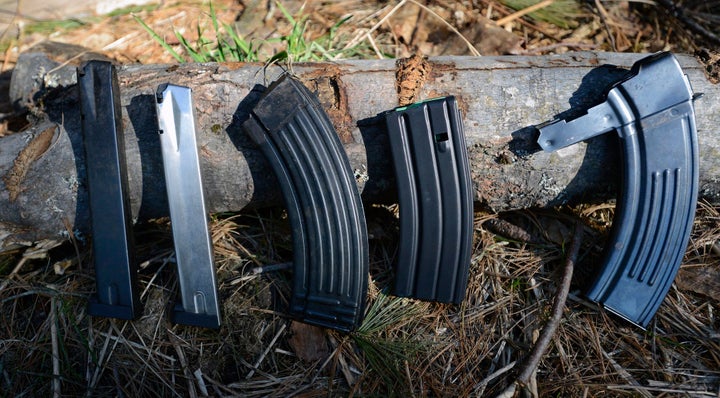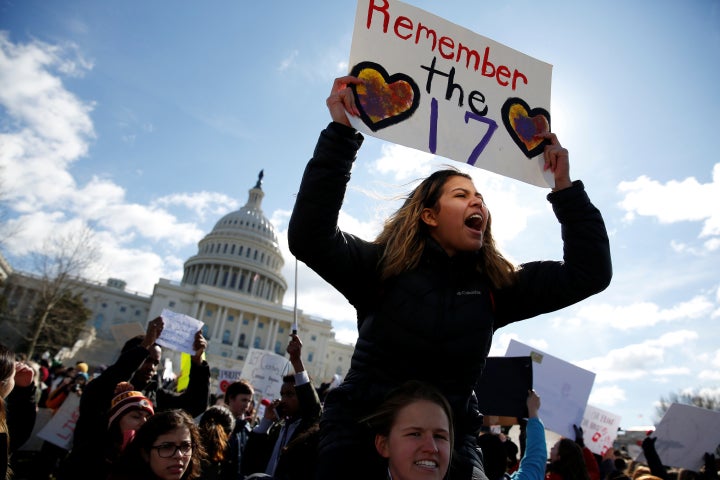
A gunman entered Marjory Stoneman Douglas High School a month ago on Wednesday and opened fire with a semi-automatic AR-15-style rifle, killing 17 people and injuring 17 more. He shot nearly 150 rounds during the 10-minute attack, and reportedly would have continued if his weaponry had cooperated.
Instead, dumb luck brought an end to the rampage when the shooter’s rifle jammed as he attempted to reload it with a fresh magazine, law enforcement sources told Florida media outlets. Other sources suggested the perpetrator “fumbled” while trying to reload. Whether user error or a technical malfunction, this mishap appeared to save lives. With police closing in, the gunman discarded his firearm and fled the school with a bag full of ammunition, blending in with evacuating students.
In many ways, it’s a telling indictment of U.S. gun policy that 17 lives were cut short and we can feel lucky that it wasn’t worse. But if lawmakers are going to continue relying on luck alone to mitigate the carnage of mass shootings, the least they could do is work to stack the odds against murderers and in favor of their victims.
One way to do that would be to pass a federal restriction on high-capacity magazines. This would limit the number of rounds a mass shooter could fire uninterrupted, meaning they’d have to reload more often, and not be able to shoot as many people in between. More reloading would result in a higher probability of a malfunction or mistake, giving law enforcement more time to respond and bystanders more opportunity to flee or fight back.
“Even though it’s fairly easy to interchange magazines, any time you do is a point at which firing stops,” said Robert Spitzer, a professor at SUNY Cortland who’s written five books on gun policy. “People drop the magazines. They jam. In a real live fire situation, people are often nervous, even including those who are committing these crimes.”

Most standard magazines for military-style rifles like AR-15s hold 30 rounds, though 10-round versions are also common. There are conflicting reports about whether the Parkland shooter used 10-round magazines or 30-round magazines, but regardless, the incident appears to demonstrate the value of forcing criminals to reload.
Sen. Marco Rubio (R-Fla.) hinted as much during a town hall with Stoneman Douglas students last month, when he said he’d consider a ban on high-capacity magazines after being told that several people were able to escape while the shooter was reloading. He later introduced legislation that ignored magazines entirely.
Magazine capacity restrictions have been hotly debated at both the state and federal levels. The 1994 federal assault weapons ban, which expired in 2004, included a 10-round cap on magazines. That limit would be reinstated under both House and Senate bills to renew the assault weapons ban.
Eight states and Washington, D.C., have also passed measures restricting magazines of various sizes, with most implementing a 10-round limit as part of broader assault weapons ban legislation. Many of those laws have faced legal challenges, though federal courts have generally upheld them and the Supreme Court has so far declined to hear a challenge.
“If the federal government enacted a high-capacity magazine ban, it would be constitutionally permissible,” said Adam Winkler, a professor of constitutional law at the UCLA School of Law who has written extensively on gun policy.
Gun advocates often argue that the purpose of the Second Amendment is to ensure that an armed citizenry would be capable of rising up against a tyrannical government, but the Supreme Court has established that the core Second Amendment right pertains to self-defense. As long as the court maintains that position, it would be hard to justify a change on this issue, said Adam Skaggs, chief counsel of the Giffords Law Center to Prevent Gun Violence.
“Having 10 rounds of ammunition to fire doesn’t materially infringe [on] the ability to use the gun for self-defense, especially when considered in light of the state’s interest to limit the ability of shooters to commit mass carnage,” he said.
But to probe the issue of civilian versus government firepower a bit deeper, it’s worth noting that many high-capacity magazines available to the public are larger than the 30-round magazines law enforcement and domestic military personnel typically use. The Las Vegas gunman last October was equipped with a number of 100-round magazines, for example.
“Having 10 rounds of ammunition to fire doesn’t materially infringe [on] the ability to use the gun for self-defense, especially when considered in light of the state’s interest to limit the ability of shooters to commit mass carnage.”
- Adam Skaggs, chief counsel of the Giffords Law Center to Prevent Gun Violence.
While we’re weighing if civilians should have access to more than 10 rounds in a magazine, perhaps we should be asking the same of government agents. After all, if police or military officers can’t hit what they’re aiming for in 10 shots, maybe they shouldn’t be able to shoot another 20 rounds without reloading.
Although the federal assault weapons ban legislation includes an exception for law enforcement, making it a universal restriction might help reverse the vicious cycle of militarization of both civilians and the state, said Skaggs.
“The argument is that we make these products legal, giving criminals the ability to get these magazines, so we have to arm our law enforcement with more and more militaristic weapons because the civilian population has them,” Skaggs said. “It creates a one-way ratchet. Each side has to continually be more armed.”
High-capacity magazine bans have traditionally been considered in conjunction with more sweeping assault weapons ban legislation, but there may be a few reasons to introduce such proposals on their own.
Magazine capacity restrictions are slightly less politically polarizing than assault weapons bans, according to recent surveys, with some polls showing majority support even among Republicans. At the same time, many experts predict that restricting high-capacity magazines would be just as effective at reducing mass shooting deaths as banning assault weapons.
There are also legitimate questions about the scope of assault weapons bans. Although it’s clear that just one bullet from a military-style rifle can inflict horrific damage to a human body, the same can be said of most rifles, including non-military style rifles that fire higher caliber rounds more slowly. In mass shooting scenarios, the elevated threat of a rifle like an AR-15 is primarily a function of its high volume and rate of fire, not the cosmetic features and other attachments often associated with so-called assault weapons.
By focusing on how many rounds a weapon can shoot before it has to be reloaded, a high-capacity magazine ban more narrowly addresses the lethality of the firearm, said Winkler.
“It makes a lot more sense, public policy-wise, to ban high-capacity magazines than it does to ban military-style rifles,” he said.
“It makes a lot more sense, public policy-wise, to ban high-capacity magazines than it does to ban military-style rifles.”
- Adam Winkler, professor of constitutional law at the UCLA School of Law
But such an effort would also pose significant challenges. High-capacity magazines have been standard issue on some of the most popular rifles sold in the U.S. in recent decades, meaning there are tens of millions of them already out there. States that have banned high-capacity magazines have generally outlawed the sale and manufacture of new devices, while grandfathering in the possession of items that were legal when the ban was enacted. The federal proposals include a similar clause.
When implemented on a state-by-state basis, these restrictions can be easily circumvented. Someone in a state where high-capacity magazines are banned can simply purchase them in a more gun-friendly state and bring them home. Although those magazines might technically be illegal under state law ― and transporting them across state lines certainly would be ― they don’t typically come stamped with a manufacture date, meaning law enforcement generally wouldn’t be able to tell the difference between a banned device and a legally possessed one.
These are inherent weaknesses with the system of federalism, especially when it comes to gun laws, and further evidence that regulating high-capacity magazines might be best addressed at the federal level. But the current proposal would likely raise enforceability issues as well, simply because it would be difficult to keep track of the devices that get grandfathered in.

Despite the complications, Spitzer maintains any move toward restricting high-capacity magazines is a step in the right direction.
“At least you’re not producing and selling more of them,” he said. “If your basement is filling with water because of a broken pipe, the first thing you do is turn off the water. It doesn’t eliminate the water in the basement, but at least it keeps more water from coming in.”
Still, it’s important to be realistic about the limitations of a high-capacity magazine ban. The current debate comes in response to increasingly frequent and deadly mass shootings, in which many of the perpetrators have used military-style rifles and high-capacity magazines. These incidents are deeply troubling and deserving of a policy response that can begin to reverse this bloody trend, even if it can’t prevent it altogether. But mass shootings are also a small problem of the overall gun violence picture, and they look markedly different than the overwhelming majority of incidents, which involve handguns outfitted with standard-capacity magazines.
“I don’t think anyone would argue with a straight face that if we limit people to magazines of 10 or 15 rounds we’d solve the entire gun violence problem, but what we can do is expect to have a real effect on how many people are injured and killed in mass shooting incidents,” said Skaggs.
And it might take patience to see results.
“When you have 350 million guns out there, any law you adopt is going to take a long time to work, if it works at all,” said Winkler. “It’s a reform that would take generations to work, rather than days or months.”
Of course, there are more cynical reasons to think a high-capacity magazine ban might not get much support at the federal level. With Republicans in control of all three branches of government and showing little interesting in opposing the National Rifle Association, even the soundest of reasoning might not make a difference.
“It’s not about the logic of the argument, but the principle of no new gun control laws that’s really driving the NRA,” said Winkler.
